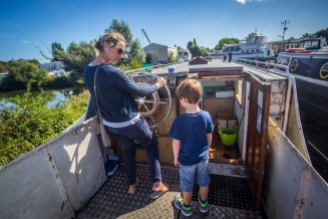Last week and this week the major work started. Hooray!
When I say the major work, I mean the top priority, foundational and expensive stuff involved in A) not sinking, and B) not dying.
The pretty, fun, custom interior and furniture stuff continues to be placed at the bottom of our Trello board. (Except in my daydreams, staring out the window, where I have mapped out every single detail and am already living there in my mind palace, making coffee. Don’t tell Chris).
Grit-blasting vs blacking
Odin’s steel hull is being grit-blasted to take her back to raw steel, then re-painted with 2 layers of a super protective primer and a black satin paint finish. It’s part way through and it’s already looking AH-mazing.
This process is a really messy one involving a big scary machine that shoots grit at high pressure, directly at a frightened little boat to remove all the muck, gunk, zebra mussels and rust that collects during a tough little waterways life. It’s not her fault! Don’t judge her!

99 times out of 100*, steel-hulled boat owners use a bitumen paint to treat and protect their hull against the elements. This process is commonly called blacking.
Blacking is normally done every 2 – 4 years after pulling the boat out of the water briefly, scrubbing some surface hull grime away, painting directly over all the remaining muck and gunk stuck to the hull, then popping the boat back in the water.
One contractor we’re using for a different task, a boating expert of 35 years, shook his head vehemently after I told him we were going to grit-blast rather than black the hull.
“I wouldn’t do that if I were you,” he said, “it’ll open up a whole can of expensive worms. You don’t want to expose all those problems.”
At the time, when I explained (gingerly, using my best, modest, new boat owner tone) that we’d already committed to the grit, I felt a chill go down my spine. What if Odin’s hull turns into a sieve? The Ultra Sonic Test (UST) on the hull was only a spot test in uniform spaces, after all. What if we wouldn’t be able to get her back on the water for months and months? What if the welding to fix the imaginary giant issue costs a crazy fortune?
We let the risks sink in, then we told ourselves it was better to know. Blacking over an issue might well hide it for a year or so, but isn’t it better to know the honest-to-Odin reality?
We decided it’s better to find and fix any issues now, than to wait until we see water seeping through the floor boards and into my future duck egg coloured coffee cup.

So what’s the damage? It’s still not entirely clear, the grit blasting has uncovered a few minor holes that will need to be welded, but generally speaking, everything is OK with no catastrophic costs involved… as far as we can tell. So far. Watch this space. Cross everything.

Ongoing tinkering projects
While the professionals sort out the not sinking priorities, we’ve been donning our very special new work attire and getting stuck into a few more tinkering projects.
Here’s our current tinkering list in no specific order: cutting off the old anodes and in the process cutting a bit too far into the hull (not looking at anyone in particular Chris), oiling the oak windows, re-sealing the portholes, siliconing porthole cracks, stripping paint and sanding the front door, scrubbing the decks (AGAIN), cleaning the storage lockers, buying and preparing the new mushroom vents, working out how to best lock the boat, filling and testing the water storage and pumps, cleaning and emptying the engine room, are you asleep yet? It’s longer still, but I’ll stop there.
I’ll leave you with a couple of pictures of when my sister and her 3 kiddos came to visit Odin in the boat yard last week. As you can see, boat restoration projects are absolutely the height of fun for teenage nieces. My sister and little nephew were much more amused.
They will all be much more impressed with the mind palace version, mark my words.
*99 times out of 100 is not a real fact


